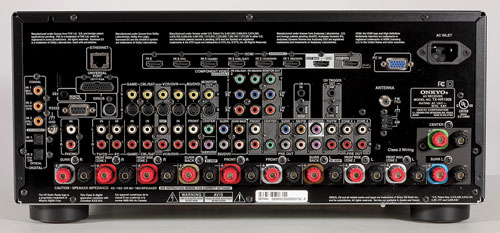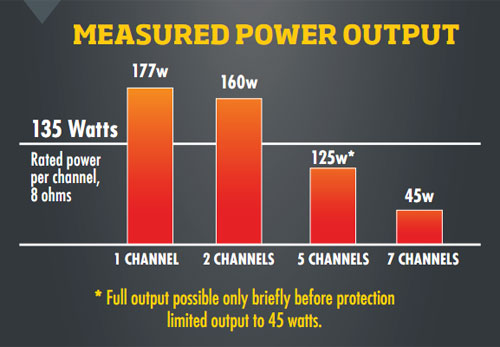Test Report: Onkyo TX-NR1008 A/V Receiver Page 4

TEST BENCH

DOLBY DIGITAL PERFORMANCE
All data were obtained from various test DVDs using 16-bit dithered test signals, which set limits on measured distortion and noise performance. Reference input level is -20 dBFS, and reference output is 1 watt into 8 ohms. Volume setting for reference level was 74.5. All level trims set at zero. Except for subwoofer-related tests, all speakers were set to "large," subwoofer on. All are worst-case figures where applicable.
Output at clipping (1 kHz into 8/4 ohms)
1 channel driven: 177/272* W (22.5/24.3 dBW)
5 channels driven (8 ohms): 125 W (21.0 dBW)
7 channels driven (8 ohms): 45 W** (16.5 dBW)
*Software impedance switch at "6 ohm" position; with switch in "4 ohm" position, power into 4 ohms limited to approximately 65 W.
**Full output possible for only a second or less, following which the unit would enter protection, limiting output to approximately 45 W.
Distortion at 1 watt (THD+N, 1 kHz)
8/4 ohms: 0.02/0.03%
Noise level (A-wtd): -77.3 dB
Excess noise (with sine tone) 16-bit (EN16): 0.3 dB
Frequency response: 20 Hz to 20 kHz +0, -0.2 dB
MULTICHANNEL PERFORMANCE, ANALOG INPUT
Reference input and output level is 200 mV; volume setting for reference output level was 78.5. Distortion (THD+N, 1 kHz, 8 ohms): 0.03%
Noise level (A-wtd): -90.0
Frequency response: <10 Hz to >200 kHz +0, -2.9 dB
STEREO PERFORMANCE, DIGITAL INPUT
Reference level is -20 dBFS; all level trims at zero. Volume setting for reference level was -3.5.
Output at clipping (1 kHz, 8/4 ohms, both channels driven): 160/229*** W (22.0 /23.6 dBW)
*** With software impedance switch at "4 ohms," protection circuits would trigger after a few seconds, limiting steady-state output to approximately 45 W.
Distortion at reference level: 0.02%
Linearity error (at -90 dBFS): 0.1 dB
Noise level (A-wtd): -75.4 dB
with 96-kHz/24-bit signals: -86.2 dB
Excess noise (with/without sine tone) 16-bit (EN16): 0.3/0.6 dB
quasi-20-bit (EN20): 10.6/10.2 dB
Noise modulation: 0.2 dB
Frequency response: less than 10 Hz to 20 kHz +0, -0.1 dB
with 96-kHz/24-bit signals: less than 10 Hz to 44.4 kHz +0, -0.7 dB
BASS-MANAGEMENT PERFORMANCE
Measured results obtained with Dolby Digital test signals.
Subwoofer-output frequency response (crossover set to 80 Hz): 24 dB/octave above -6-dB rolloff point of 80 Hz
High-pass-filter frequency response (crossover set to 80 Hz): 12 dB/octave below -3-dB rolloff point of 81 Hz
Maximum unclipped subwoofer output (trim at 0): 8.2v
Subwoofer distortion (from 6-channel, 30-Hz, 0-dBFS signal; subwoofer trim set to 0): 0.02%
Crossover consistency: bass-crossover frequency and slope were consistent for all sources and formats.
Speaker size selection: all channels can be set to "small"
Speaker-distance compensation: available for all main channels
Onkyo's latest effort yielded excellent numbers overall, with frequency-response, noise, and distortion results all pleasingly close to theoretically perfect figures. Power output into two channels was more than generous, bettering the manufacturer's 135-watts spec by a full decibel or better. Driving multiple channels for more than a second or two (or more than a half-second or so when five or more channels were involved) triggered the TX-NR1008's protection mode, limiting clean output to a bit less than 50 watts all around. I note as always that such multichannel, in-phase signals essentially never occur "in nature" from music or movie soundtracks - only artificial test signals. As expected, dynamic test signals such as the old IHF dynamic-headroom pulse (and music/movie program material) did not induce the same effect. At no time in my listening did I notice the receiver entering protection, reducing dynamics, or limiting power in any unexpected way.-D.K.








































